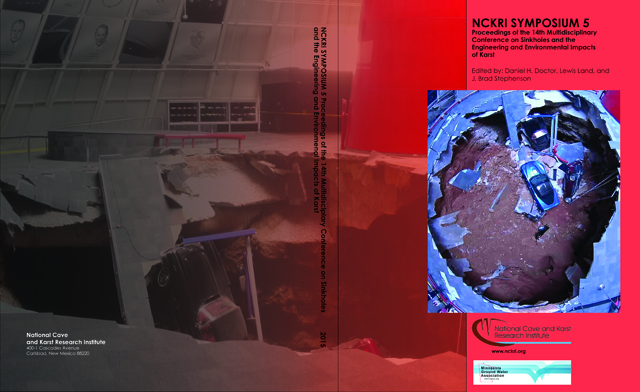Abstract
This study is focused on numerical simulation of the formation and development of karst soil caves related to cover-collapse sinkholes. The so-called ‘karst soil cave’ refers to the caves formed in the soil layers above bedrock of sinkhole regions. Because the soil caves are formed and developed under groundwater seepage, studying groundwater level changes can help understand soil cave development and collapse. Based on the improved Terzaghi loosening pressure theory and using excess pore water pressure, two kinds of critical groundwater level decline are discussed. The first, denoted as ∆H0, is the critical groundwater level decline related to soil cave formation and evolution; the other one, denoted as ∆HT, is the critical groundwater decline related to cave roof collapse. After a soil cave is formed, its evolution can cause uneven displacement and stress redistribution in the overlying soil layer. The process of soil cave expansion can be understood by investigating the change in displacement and stress. Numerical simulation of the vertical displacement using FLAC3D shows that the maximum vertical displacement occurs at the arch roof of the soil cave and that the displacement can cause tensile failure of the arch roof. The simulated soil layer displacement is used to determine the soil depth disturbed by the cave by delineating the planes of equal settlement. Analyzing the simulated shear stress shows that the maximum shear stress occurs at the arch toes and causes shear failure. On the other hand, the zones of low shear stress can be used to evaluate existence of arching effect in the overlying soil layer. By analyzing the plastic zone of the soil layer, it was found that, in rigid clay, arch roof collapse and tensile failure are the major events that lead eventually to the barrel-shaped or bottle-shaped forms of collapsed pits. In loose soil, shear failure of the arch toe is the major event that eventually leads to the taper-shaped or bowl-shaped form of collapsed pits. Generally speaking, stability and size of soil caves can be determined using the three variables of low shear stress area, equal settlement plane, and plastic zone discussed above. The numerical simulation of this study is valuable to the monitoring and assessment of sinkhole occurrence.
Rights Information

This work is licensed under a Creative Commons Attribution 3.0 License.
DOI
http://dx.doi.org/10.5038/9780991000951.1028
Included in
Computational Engineering Commons, Environmental Engineering Commons, Geotechnical Engineering Commons
Numerical Simulation of Karst Soil Cave Evolution
This study is focused on numerical simulation of the formation and development of karst soil caves related to cover-collapse sinkholes. The so-called ‘karst soil cave’ refers to the caves formed in the soil layers above bedrock of sinkhole regions. Because the soil caves are formed and developed under groundwater seepage, studying groundwater level changes can help understand soil cave development and collapse. Based on the improved Terzaghi loosening pressure theory and using excess pore water pressure, two kinds of critical groundwater level decline are discussed. The first, denoted as ∆H0, is the critical groundwater level decline related to soil cave formation and evolution; the other one, denoted as ∆HT, is the critical groundwater decline related to cave roof collapse. After a soil cave is formed, its evolution can cause uneven displacement and stress redistribution in the overlying soil layer. The process of soil cave expansion can be understood by investigating the change in displacement and stress. Numerical simulation of the vertical displacement using FLAC3D shows that the maximum vertical displacement occurs at the arch roof of the soil cave and that the displacement can cause tensile failure of the arch roof. The simulated soil layer displacement is used to determine the soil depth disturbed by the cave by delineating the planes of equal settlement. Analyzing the simulated shear stress shows that the maximum shear stress occurs at the arch toes and causes shear failure. On the other hand, the zones of low shear stress can be used to evaluate existence of arching effect in the overlying soil layer. By analyzing the plastic zone of the soil layer, it was found that, in rigid clay, arch roof collapse and tensile failure are the major events that lead eventually to the barrel-shaped or bottle-shaped forms of collapsed pits. In loose soil, shear failure of the arch toe is the major event that eventually leads to the taper-shaped or bowl-shaped form of collapsed pits. Generally speaking, stability and size of soil caves can be determined using the three variables of low shear stress area, equal settlement plane, and plastic zone discussed above. The numerical simulation of this study is valuable to the monitoring and assessment of sinkhole occurrence.

